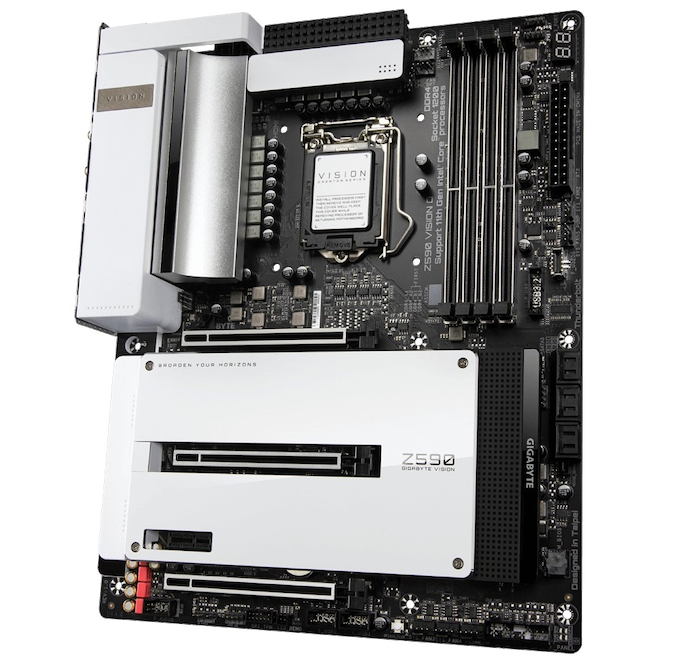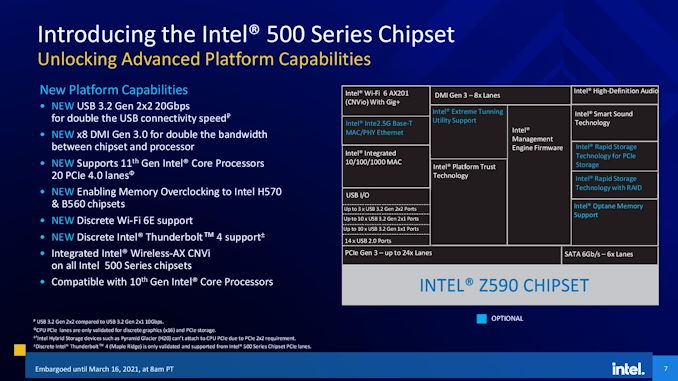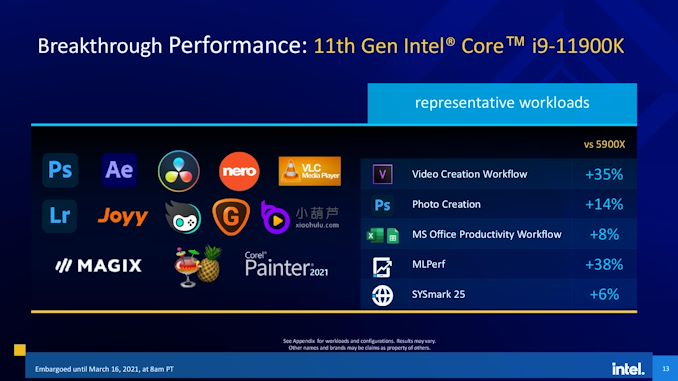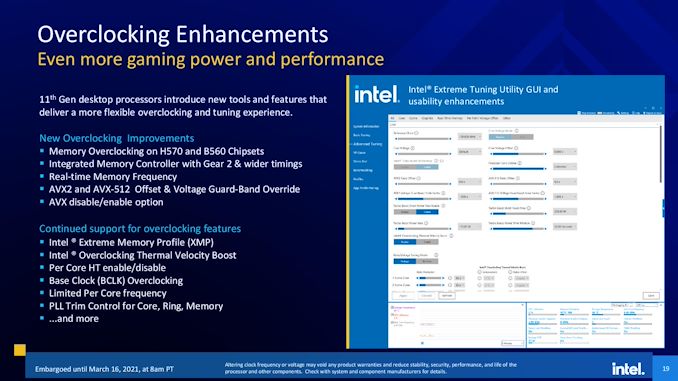Intel Launches Rocket Lake 11th Gen Core i9, Core i7, and Core i5
by Dr. Ian Cutress on March 16, 2021 11:00 AM ESTMotherboards and 500 Series Chipset
All of these new processors are LGA1200 processors, and a result they will be enabled in 500-series motherboards. There is also some 400-series support, however it depends on the platform. Here’s the trusty AnandTech Guide for support:
| Motherboard Support | |||
| AnandTech | B460 H410 |
Z490 Q470 H470 |
Z590 B560 H510 |
| Comet Lake | Yes | Yes | Yes |
| Rocket Lake | No | Yes | Yes |
The reason why Rocket Lake will not work in H410 or B460 motherboards is because these chipsets are built on Intel’s older 22nm process. There is something in the design of those chipsets, likely to be related to signal integrity, which means they cannot be supported, at least at the PCIe 3.0 speeds required. Given previous motherboard firmware, we might see unofficial support later down the line, even if only in PCIe 2.0 mode.
However, the lead platform for Rocket Lake will be the Z590 platform. We’ve already published a large overview of the 50+ motherboards on the market, but the new features boil down to:
- Double CPU-to-Chipset bandwidth when paired with 11th Gen RKL
- USB 3.2 Gen 2x2 (20 Gbps) native chipset connectivity
Here's the comparison of Z590 compared to the two previous generations of Intel high-end motherboards:
| Intel Z590, Z490, and Z390 Chipset Comparison | |||
| Feature | Z590 | Z490 | Z390 |
| Socket | LGA1200 | LGA1200 | LGA1151 |
| PCIe Lanes (CPU) | 20 | 16 | 16 |
| PCIe Specification (CPU) | 4.0 | 3.0* | 3.0 |
| PCIe Config | x16 x8/x8 x8/x8/x4+4 |
x16 x8/x8 x8/x8/+4 |
x16 x8/x8 x8/x4/+4 |
| DMI Lanes (3.0) | x8 (RKL) | x4 | x4 |
| Chipset PCIe 3.0 Lanes | 24 | 24 | 24 |
| Max USB 3.2 (Gen2/Gen1) | 6/10? | 6/10 | 6/10 |
| USB 3.2 Gen 2x2 (20 Gbps) | Y | ASMedia | N |
| Total USB | 14 | 14 | 14 |
| Max SATA Ports | 6 | 6 | 6 |
| Memory Channels (Dual) | 2/2 | 2/2 | 2/2 |
| Intel Optane Memory Support | Y | Y | Y |
| Intel Rapid Storage Technology (RST) | Y | Y | Y |
| Max Rapid Storage Technology Ports | ? | 3 | 3 |
| Integrated WiFi MAC | Wi-Fi 6 | Wi-Fi 6 | Wi-Fi 5 |
| Intel Smart Sound | Y | Y | Y |
| Integrated SDXC (SDA 3.0) Support | ? | ? | Y |
| Overclocking Support | Y | Y | Y |
| Intel vPro | N | N | N |
| Max HSIO Lanes | ? | 30 | 30 |
| ME Firmware | 15 | 14 | 12 |
| TDP (W) | 6 | 6 | 6 |
The new H570 and B560 motherboards reintroduce memory overclocking, a feature that was removed from the 400-series budget motherboards.
Here is the slide Intel provided for 500-series, though it is worth mentioning some of the caveats:
In this slide, it states that discrete Wi-Fi, 2.5 gigabit Ethernet, and Thunderbolt 4 are supported on 500 series. These are optional upgrades for the motherboard vendors, so not all motherboards will have them, and in each case they also require additional hardware costs for the motherboard manufacturer, such as an RF module for Wi-Fi, a PHY for Ethernet, or a PHY for Thunderbolt. These could all be added to any other motherboard, AMD or Intel, with discrete controllers which are slightly more expensive – those controllers don’t have to be Intel either. But to be clear, they are not unique to offerings to Z590, nor are they natively offered by default on all systems.
All of the 10th Generation Comet Lake processors will work in all 500-series motherboards, and get all the features, except the double CPU-to-Chipset bandwidth, as that specifically requires Z590 + 11th Gen Core CPU.
It should be noted that anyone already with a 400-series or 500-series motherboard, or those looking to purchase one, will need a BIOS update in order to enable the latest performance enhancements. In our testing, we found that the BIOS on our boards when they arrived in our offices were quite old (from January), and the latest microcode from Intel should help increase performance and cache latency. Some may be updated to February microcode, which does get most of the way there to peak performance, but the latest should always give the best results.
Performance and Overclocking Enhancements
For users looking for performance data, we have already reviewed a retail unit of the Core i7-11700K, and we thoroughly encourage you to check out that review. Intel’s own numbers for today’s launch use a variety of best-case scenario workloads that emphasize Intel’s internal accelerators rather than raw core performance – it should also be noted that Intel now considers MLPerf a ‘representative workload’, which is a far cry from the real world workload messaging we received only two generations ago.
On the Overclocking Enhancement side of things, this is perhaps where it gets a bit nuanced. For a while now Intel has been binning its K processors to within an inch of their maximum supported frequencies, and turbo boost techniques like favored core and Thermal Velocity Boost also push the margins on the cores that support it. So what can Intel focus on for overclocking this time round?
With Rocket Lake, Intel is leaning into the memory side of things. These new Rocket Lake processors now support geared ratios between the memory controller and the DRAM data rates. Traditionally on Intel these have operated on a 1:1 ratio, and in order to push that DDR4-5000 memory, like we did in our review of that premium Corsair kit, it required a processor with a good memory controller. With the 2:1 ratio, the memory controller will now operate at half speed, in a more comfortable zone, allowing memory overclockers to go beyond traditional limits – DDR4-5000 means that the memory controller is now only operating at 1250 MHz, rather than 2500 MHz (because DDR4 is measured in transfers per second, and there are two transfers per clock in Double Data Rate DDR memory). This also means that in order to match the internal clocks on DDR4-3200, users will have to start pushing the memory itself to DDR4-6400 to get the memory controller back on a level footing when in that 2:1 ratio. Nevertheless, this feature does allow the memory to be tested to its limits without the bottleneck of the CPU.
As mentioned in the previous page, Intel is going to use default gearing as a factor in product differentiation. The Core i9-K and i9-KF processors will officially support DDR4-3200 at 1:1, while all other CPUs support DDR4-3200 at 2:1. All CPUs will also support DDR4-2933 at 1:1. It should be noted however that motherboard manufacturers seem to be ignoring this - all the motherboards we have tested to date run at DDR4-3200 at Gear 1:1 regardless of the CPU. This is likely because the motherboard vendors feel confident in the ability of their products to enable 1:1 in all situations.
Also on memory overclocking, users that have tried this will note that in order to change the memory ratio, it requires a restart. With the new Z590 system, Intel has devised a system that will let a user select two different memory ratios, and it will enable both at boot time. Then, once in the operating system, a user can switch between them for different benchmarking modes. What this does is allow extreme overclockers, particularly those going for world records with sub-zero coolants, to boot at the lower memory speed, then run the test at a higher memory speed, then instantly revert back to the slow speed. Currently they have to run at the high speed all the time, which can be liable to instability. It’s more one for the extreme overclockers, but Intel has added it here.
Other new features in the overclocking toolkit include AVX-512 offsets and voltage guard bands, enabling users to overclock the processors without overclocking AVX-512 and incurring a heavy power consumption penalty. Intel has also put in an option to disable AVX altogether, which means that users who don’t want to worry about AVX-512 draining almost 300 W from an errantly loaded program, it can be disabled directly in the firmware.
Intel is also continuing support for a number of overclock-related features, such as per-core HyperThreading, per-core frequency adjustment, and fine-grained PLL controls. Intel has stated that with Rocket Lake, it has opened up some of the features to enable proper BCLK overclocking again, however we wait to see if there is a good range for overclockers to play with.
All these new features are enabled when a 500-series motherboard and a new Rocket Lake 11th Generation Core processor. Support with Comet Lake will be limited.
What Happens Now
Intel has officially confirmed to other press outlets on the record that retail of these processors will start on March 30th. Expect to see reviews of the top processors go live around the same time, or you can read our Core i7-11700K review today (because a retailer sold some early, and we got one to test).














156 Comments
View All Comments
ZoZo - Wednesday, March 17, 2021 - link
Is that supposed to invalidate my observation?Bagheera - Wednesday, March 17, 2021 - link
yes, because Skylake is 2015 and Ice Lake is technically a 2019 part. just because Intel kept making Skylake until 10th gen doesn't automatically make the 19% ipc uplift amazing - keeping on mind what you are comparing against.also keeping on mind Zen 3 was 19% ipc from Zen 2, in one generation - and AMD was playing catch-up this whole time. that's more impressive than what Intel's done, quick is slapping a 2019 arch onto an old node and calling it something "new" because it's faster than an arch from 2015. no duh.
TheinsanegamerN - Thursday, March 18, 2021 - link
20% more IPC? Since when? IPC has been stagnant since skylake. And all that IPC does jack shit int hebenchmarks where the rocketlake CPUs occasionally lose to comet lake and consistently lose to zen 3.Integrated graphics? Intel fanbois constantly whine about those.
You can connect a SSD to your CPU direct now. Congrats on getting to where AMD has been for years.
abufrejoval - Tuesday, March 16, 2021 - link
What's almost more interesting than the technology (which seems to have very few really unkowns left), are the supply chain struggles behind the scenes, consumers never really cared about in this CPU domain before.Judging by my Tiger Lake i7 NUC and my Ryzen 5800X, both CPU core designs and manufacturing processes seem so very close to each other, few could probably tell a double sized Tiger Lake APU and a Ryzen 5800U apart.
But it's the foundry capacity constraints of TMSC and the yield issues with Intel's 10nm which are really the decisive factors in this battle with it's long term implications which come simply from market share or the size of the eco-system, not the technology details.
And this battle is fought on so many distinct fields, even if the manufacturing capacities are largely global (especially with the AMD CCDs). We hear about 10nm big Xeons and notebook SKUs being produced en masse, while today we reminded how Intel would rather resort to backporting a whole design than yield the desktop and we mostly wonder if it's done because the psychological impact of being a loser on the desktop was considered a risk big enough to do this or if Rocket Lake quite simply is commercially viable the way it is.
29a - Tuesday, March 16, 2021 - link
It would be nice to see what the iGPU is capable of.shabby - Tuesday, March 16, 2021 - link
It can't mine if that's what you're wondering 😂abufrejoval - Tuesday, March 16, 2021 - link
Got NUC8 (48EU Iris 655+), NUC10 (24EU HD620) and NUC11 (96EU Xe) and an Iris 550 Plus (48EU) on a Skylake i5 here.From the various benchmarks I've run I have good reason to believe that the 32EU Xe will perform very close to the 550 Iris Plus with 48EU, which is certainly better than all HDxxx GPUs since Skylake, but certainly not twice as fast as 48 vs 24 EU would imply (the 550 GT3e with 64MB eDRAM wasn't either).
That the 96EU on Tiger Lake without eDRAM manages to achieve a significant boost vs even the 655 Iris plus with 128MB eDRAM, is quite remarkable, but in absolute terms still might only satisfy the seriously bored without access to a gaming rig.
Expect perfectly reasonable 2D and media performance at 2x 4k resolution, good-enough Google-Earth 3D with Chrome and nothing but disappointment in gaming for these desktop SKUs.
yeeeeman - Tuesday, March 16, 2021 - link
It is obvious that this is just a stopgap for intel. A stupid decision that was made a few years back and now..it is too late to be cancelled. I also think that the current situation is favorable because intel has its own fabs and can made as many as the market asks compared to amd which is at the mercy of tsmc. So I think these will actually sell well with the 11700k looking like a good option.Qasar - Tuesday, March 16, 2021 - link
yea. only if zen 3 is not instock at the time, and the person doesnt want to wait. and the 11700k would still be the bad option.drothgery - Tuesday, March 16, 2021 - link
Of course it's a stopgap. Pretty much everything Intel's launched on the desktop since Skylake has been a stopgap (though pre-Ryzen 3, they were more than Good Enough stopgaps).But that doesn't mean it was a stupid decision (though if Adler Lake desktop parts launch this year and availability is good -- and that may very well happen -- it may have been a wrong one) given the state of Intel 10nm at the time they would have decided to make it, and would have been a better decision if they'd done it sooner.